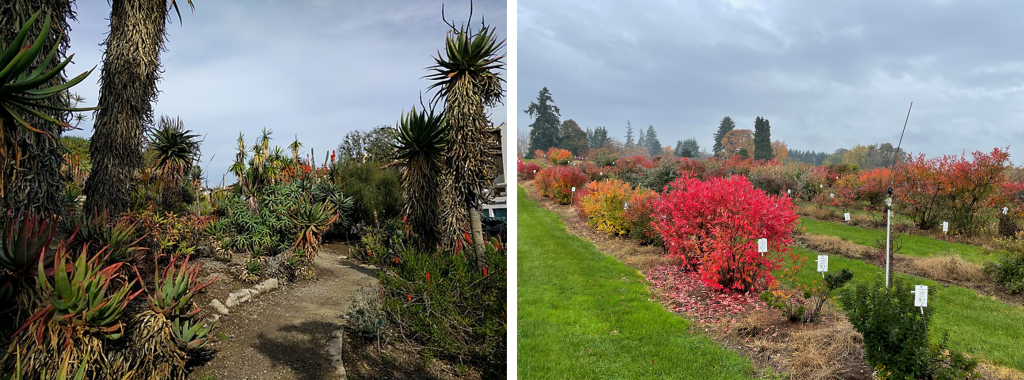The need for plant genetic resource collections in a climate change context
Gayle M. Volk, USDA-ARS National Laboratory for Genetic Resources Preservation, 1111 S. Mason St., Fort Collins, Colorado USA 80521 (Gayle.Volk@usda.gov)
Tara L. Moreau, University of British Columbia Botanical Garden, 804 SW Marine Drive, Vancouver, BC Canada V6T 1Z4 (Tara.Moreau@ubc.ca)
Learning Objectives
Introduce the concept of plant collections and their importance in addressing climate change.
outline
- Introduction
- Ex situ plant collections
- Importance of plant collections in a climate change context
- Conclusions
- References
- Acknowledgments
1. introduction
Agricultural production systems increasingly make use of monoculture systems, which could be particularly vulnerable to changing climatic conditions due to a lack of diversity. In addition to modifying operational practices, ensuring access to a diversity of plant genetic resources could help overcome these vulnerabilities. Alternative varieties and crops can be identified or developed by large-scale crop evaluations and breeding efforts. Both evaluation trials and breeding programs need access to plant genetic resources that represent a wide genetic base to provide the genetic underpinning of key traits for climate adaptation as well as novel crops adapted to the new environments (Volk et al., 2021).

2. ex situ plant collections
Plant genetic diversity can be found in natural settings (in situ) or in ex situ plant collections such as genebanks, community seedbanks, and botanical gardens. In these ex situ collections, plant genetic resources along with their associated passport data have been acquired through donations, plant collection expeditions, and plant exchanges. These collections conserve vast amounts of plant genetic diversity as quiescent or actively growing material that is accessible and available for breeding, production, research, and enjoyment (Volk et al., 2023). For instance, the USDA National Plant Germplasm System maintains over 15000 species and each year distributes material from about 250000 accessions to researchers and breeders around the world (Byrne et al., 2018). In addition to their agricultural value, plant genetic resources maintained ex situ are protected from loss due to environmental disturbances or extreme weather events, and can therefore be used to restore plants in natural settings.

Actively growing ex situ collections including public gardens and genebank field plantings provide a wide range of plants at a single location, facilitating comparisons across species and among cultivars within species. A network of over 3700 botanical gardens around the world conserves plants and performs significant public education and outreach with regard to plants and biodiversity (BGCI, 2022). This large number of botanical gardens provides opportunities to observe and research plant responses across a wide range of environments, which might help identify new species, crops, and cultivars that can be grown in a specific location in response to altered growth conditions.

3. importance of plant collections in a climate change context
Access to plant genetic resources can be provided by large international and national genebanks or smaller scale community seedbanks that offer opportunities to share local varieties that might not be available anywhere else. These collections offer novel forms of plant genetic diversity that can be evaluated under a wide range of environmental conditions and screened in controlled environments. Evaluation trials provide insights into plant responses to future climate scenarios. Similarly, evaluation trials determining resistance and/or susceptibility to pests and pathogens could identify desirable varieties when new biotic threats are encountered. The resulting information can be used to identify crop cultivars and ornamentals that exhibit desirable traits, or those that can be used in breeding programs to develop new varieties of crops adapted to the changing environmental conditions. These plants might have attributes and traits including tolerance to temperature and water extremes, efficient use of nutrients, retained productivity despite unpredictable weather patterns, and uniform yields that minimize production waste (Loboguerrero et al., 2019; Volk et al., 2023). Increased production and input use efficiency can be attained by selecting varieties that have minimal harvest and post-harvest storage losses and retain quality until consumer use (Anderson et al., 2020; Bajželj et al., 2020). One international genebank that conserves wheat and maize, CIMMYT, has a new project focused on identifying and using plant genetic resources from genebanks for climate-smart agriculture.

4. Conclusions
The future of agriculture depends on access to plant genetic diversity protected in situ and maintained in ex situ collections, typically within genebanks and botanic gardens. Actively growing material in these collections provide the unique opportunity to for large-scale comparisons of plant development across varieties and across environmental conditions. Genebanks and seedbanks make plant genetic resources available for use in breeding programs and for direct plantings that can be used to assess environmental adaptiveness. Thanks to this source of novel and desirable genetic variation, breeders and researchers across the globe have the diversity necessary to identify and develop new varieties and crops that remain productive despite the abiotic and biotic threats imposed by a changing climate.
5. references
Anderson R, Bayer PE, Edwards D. 2020. Climate change and the need for agricultural adaptation. Current Opinion in Plant Biology 56:197-202. DOI: 10.1016/j.pbi.2019.12.006
Bajželj B, Quested TE, Röös E, Swannell RPJ. 2020. The role of reducing food waste for resilient food systems. Ecosystem Services 45:106-115. DOI: 10.1016/j.ecoser.2020.101140
BGCI. 2022. Garden Search. Botanic Gardens Conservation International. Richmond, UK. Accessed on 30 December 2022. Available from: tools.bgci.org/garden_search.php
Byrne PF, Volk GM, Gardner C, Gore MA, Simon PW, Smith S. 2018. Sustaining the future of plant breeding: The critical role of the USDA-ARS National Plant Germplasm System. Crop Science 58:451-468. DOI: 10.2135/cropsci2017.05.0303
Loboguerrero AM, Campbell BM, Cooper PJM, Hansen JW, Rosenstock T, Wollenberg E. 2019. Food and earth systems: Priorities for climate change adaptation and mitigation for agriculture and food systems. Sustainability 11:1372. DOI: 10.3390/su11051372
Volk GM, Byrne PF, Coyne CJ, Flint-Garcia S, Reeves PA, et al. 2021. Integrating genomic and phenomic approaches to support plant genetic resources conservation and use. Plants 10:2260. DOI: 10.3390/plants10112260
Volk GM, Carver D, Irish BM, Marek L, Frances A, Greene S, Khoury CK, Bamberg J, del Rio A, Warburton ML, Bretting PK. 2023. Safeguarding plant genetic resources in the United States during global climate change. Crop Science 1-23. https://doi.org/10.1002/csc2.21003
6. acknowledgments
Citation: Volk GM, Moreau TL. 2023. The need for plant genetic resource collections in a climate change context. In: Volk GM, Moreau TL, Byrne PF. Conserving and Using Climate-Ready Plant Collections. Fort Collins, Colorado: Colorado State University. Date accessed. Available from: https://colostate.pressbooks.pub/climatereadyplantcollections/chapter/the-need-for-pgr-collections/
This eBook chapter was developed through a collaboration among USDA-Agricultural Research Service, Colorado State University, and the University of British Columbia Botanic Garden, with additional funding from the USDA-NIFA-Higher Education Challenge Grant (2020-70003-303930).
Editor: Katheryn Chen
the organs and tissues (seeds, fruits, cuttings, pollen, tissue cultures, etc.) by which plants can be propagated (synonymous with plant germplasm)
in a climate change context, taking action to prepare for and adjust to both the current and projected impacts of climate change
conserving plant genetic resources on-farm or within ecosystems
conservation of plant genetic resources outside their natural habitat
basic information about the origin of a genebank accession, such as collecting site or pedigree
genetically distinct uniquely identifiable samples of plant genetic resources within a genebank
a crop variety produced by scientific breeding or farmer selection methods

